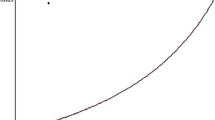Abstract
Theoretical spatial models of electoral voting tend to predict either convergence to an electoral mean (when voting is probabilistic) or chaos (when voting is deterministic). Here, we construct an empirical model of voting for the Israeli Knesset in 1992 (based on a large electoral sample and on analysis of party declarations). The probabilistic voting model so estimated fits the known election results. We then use the same model to simulate the effect of expected vote maximization by the parties. Contrary to the usual results, there is no unique convergent Nash equilibrium under this objective function. We do infer, however, that the two large parties are “Downsian”, in the sense that they maximize expected vote (up to the margin of error of the model). We suggest that the empirical results are compatible with a hybrid model of utility maximization, where each party computes the effects of its policy declaration both in terms of electoral response and of post-election coalition negotations.
Similar content being viewed by others
References
J. Adams, Multiparty spatial competition and the behavioral model of the vote, Typescript, University of California at Santa Barbara, 1996, Public Choice, forthcoming.
J.H. Albert and S. Chib, Bayesian analysis of binary and polychotomous response data, Journal of the American Statistical Association 88(1993)669–679.
R.M. Alvarez and J. Nagler, Correlated disturbances in discrete choice models: A comparison of multinomial probit models and logit models, Typescript, California Institute of Technology, 1994.
P. Aranson, M. Hinich and P. Ordeshook, Election goals and strategies: Equivalent and nonequivalent candidate objectives, American Political Science Review 68(1974)135–152.
A. Arian and M. Shamir, The Elections in Israel – 1992, SUNY Press, Albany, 1994.
E.G. Carmines and R.A. Zeller, Reliability and Validity Assessment, Sage, Beverly Hills, 1979.
A. Downs, An Economic Theory of Democracy, Harper and Row, New York, 1957.
C. Eaton and R. Lipsey, The principle of minimum differentiation reconsidered: Some new developments in the theory of spatial competition, Review of Economic Studies 42(1975)27–50.
A.E. Gelfand and A.F.M. Smith, Sampling-based approaches to calculating marginal densities, Journal of The American Statistical Association 85(1990)398–409.
I.L. Glicksburg, A further generalization of the Kakutani fixed point theorem with an application to Nash equilibrium points, Proceedings of the American Mathematical Society 38(1952)170–174.
J.A. Hausman, Specification tests in econometrics, Econometrica 46(1978)1251–71.
K. Ladha, Information pooling through majority rule voting, Journal of Economic Behavior and Organization 26(1995)353–372.
M. Laver and N. Schofield, Multiparty Governments, Michigan University Press, Ann Arbor, 1998 (2nd printing).
T. Lin, J. Enelow and H. Dorussen, Equilibrium in multicandidate probabilistic spatial voting, Typescript, University of Texas, Austin, 1996, Public Choice, forthcoming.
G.S. Maddala, Limited Dependent and Qualitative Variables in Economics, Cambridge University Press, Cambridge, 1983.
R. McKelvey and T. Palfrey, Quantal response equilibria for normal form games, Typescript, California Institute of Technology, 1994.
R.D. McKelvey and N. Schofield, Generalized symmetry conditions at a core point, Econometrica 55(1987)923–933.
D. Nachmias, and I. Sened, The bias of pluralism, Typescript, Washington University in St. Louis and Tel Aviv University, 1997. Forthcoming in: The Election of 1996 in Israel, eds. A. Arian and M. Shamir, SUNY Press, Albany.
D. Nixon, D. Olomoki, N. Schofield and I. Sened, Multiparty probabilistic voting: An application to the Knesset, Working Paper No. 186, Center in Political Economy, Washington University, 1995.
P. Ordeshook, The spatial analysis of elections and committees: Four decades of research, in: Perspectives on Public Choice, ed. D. Mueller, Cambridge University Press, Cambridge, 1997.
W. Riker, The Theory of Political Coalitions, Yale University Press, New Haven, 1962.
N. Schofield, Generic instability of majority rule, Review of Economic Studies 50(1983) 695–705.
N. Schofield, Social Choice and Democracy, Springer, Heidelberg, 1985.
N. Schofield, Existence of a “structurally stable” equilibrium for a non-collegial voting rule, Public Choice 51(1986)267–284.
N. Schofield, Political competition in multiparty coalition governments, European Journal of Political Research 23(1993)1–33.
N. Schofield, Coalition politics: A formal model and empirical analysis, The Journal of Theoretical Politics 7(1995)245–281.
N. Schofield, Research programs in preference and belief aggregation, in: Collective Decision-Making: Social Choice and Political Economy, ed. N. Schofield, Kluwer, Boston, 1996.
N. Schofield, Multiparty electoral politics, in: Perspectives on Public Choice, ed. D. Mueller, Cambridge University Press, Cambridge, 1997.
N. Schofield, B. Grofman and S. Feld, The core and the stability of group choice in spatial voting games, American Political Science Reveiw 82(1986)195–211.
N. Schofield and R. Parks, Nash equilibrium in a spatial model of coalition bargaining, Typescript, Washington University in St. Louis, 1995, Mathematical Social Sciences, forthcoming.
I. Sened, Equilibria in weighted voting games with side-payments in two-dimensional spaces, Journal of Theoretical Politics 7(1995)283–300.
I. Sened, A model of coalition formation: Theory and evidence, Journal of Politics 58(1996)350–372.
Rights and permissions
About this article
Cite this article
Schofield, N., Sened, I. & Nixon, D. Nash equilibrium in multiparty competitionwith “stochastic” voters. Annals of Operations Research 84, 3–27 (1998). https://doi.org/10.1023/A:1018997105830
Issue Date:
DOI: https://doi.org/10.1023/A:1018997105830




